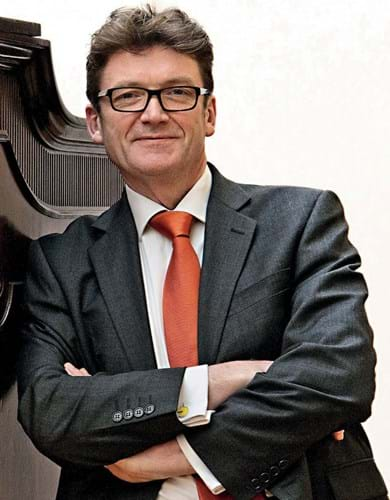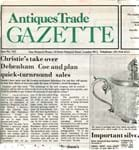For the last-ever sale at Christie’s South Kensington on July 19, chairman Nic McElhatton dug deep into his early experience as a stage hand at Newcastle Playhouse.
Dressed as James Christie, founder of the eponymous auction house in 1766, McElhatton sold the last 100 lots in theatrical style. The performance combined the art of a circus ring master, street vendor and entertainer into one.
The subtext to this drama in London SW7 seemed to be: live auction is theatre and CSK was the greatest playhouse of them all.
Ahead of the sale and afterwards, McElhatton [no relation to this writer] talked to ATG about CSK’s milestones and legacy.
ATG: What has been CSK’s impact?
Nic McElhatton: Many aspects of the market we take for granted today were pioneered at CSK. South Ken democratised the rarefied art auction world, making it accessible to all.
It was the first saleroom to have category specific sales in disciplines from cameras to Picasso ceramics, oak and country furniture to Out of the Ordinary and Souvenirs of the Grand Tour – the list goes on.
A great achievement, and one I like to take a bit of credit for, is our Interiors sales, a model now copied by auctioneers across the globe. This amalgamation of several auction categories under one umbrella was probably CSK’s biggest impact on the market we know today.
How did CSK evolve in your era?
When I joined in 1984, there were 460 auctions that year and turnover was around £25m. The trade bought 90% of our lots back then, but today private individuals buy 90%.
In 2012, CSK’s most profitable year ever, we held 118 auctions and the turnover was just shy of £140m. The digital era had a huge impact: suddenly the world was our client.
You’ve referred to “struggling with the decision to close CSK”.
It was a shock, as we were in the middle of a refurbishment and despite the fall in the number of sales, in my opinion we were still washing our faces financially.
CSK delivered more first-time buyers into the Christie’s network than any other part of the firm’s operations.
Was the diminishing number of sales not a harbinger of change?
Sales did diminish after 2012 when we held 118, down to 60 last year. The business changed and we needed to concentrate on higher-value sales, but CSK remained profitable to the end.
The reality is that it’s difficult to make a profit from high-volume sales. It was an argued point at Christie’s – at what point do we make a profit? When you throw in salaries, marketing and so on, we worked out that we broke even on a lot selling for £500-700.
Some decisions along the way were not easy, such as the demise of the wonderful collectables department in the early 2000s and dropping sales.
Can the CSK model live on digitally?
Time will tell, but nothing will ever replace the power of a live auction and bums on seats in front of an auctioneer on a rostrum. It creates a far more competitive arena, and undoubtedly higher sold prices.
For some clients, engaging remotely is easier, as Christie’s is an intimidating brand. But that remoteness and not forming relationships with clients scare me. My role was building relations with clients and helping them create collections. That relationship came to fruition when they sold those collections through us.
And while digital simplifies the process of buying at auction, it’s not a simple process. The fulfilment side is where it can fall down.
“The Christie’s brand was our best friend and our worst enemy at CSK
In your valedictory speech you said “competitors tried to replicate CSK but none of them really came close”.
There’s a lot of posturing by auctioneers about taking a slice of CSK’s action. If you have a collection with 400 lots, worth £1m, can you handle it without cherry picking?
There’s an assumption by other auctioneers that they can just step into this niche. But the Christie’s brand is so powerful in respect of selling that the issue for smaller auctioneers will be, ‘you’re not Christie’s, so you won’t get the prices’.
So the Christie’s brand is intimidating and yet it was the generator of higher CSK prices…
In that sense the brand was our best friend and our worst enemy at CSK.
Reason to be cheerful, post-CSK?
This is a seminal moment in the marketplace. The interest among the next generation of potential clients is huge, which was evident from the success of CSK ‘Lates’ sessions, when we opened our doors to the public once a month with talks by specialists and guest speakers. These events attracted over 700 people on occasions, predominantly in their late 20s to early 30s. This bodes well for the future of our industry.
Nic McElhatton: Curriculum Vitae
1977-80
Sunderland Polytechnic, BA in Fine Art
1980-1983
Freelance artist and theatre crew member
1984
Joins CSK as a porter
1989-92
Takes sabbatical to be a dealer
1992
Rejoins CSK as head of European works of art
2005
Appointed as a director at CSK
2010
Promoted to chairman
2017
Leaves Christie’s to launch own art advisory business and consult for Roseberys















